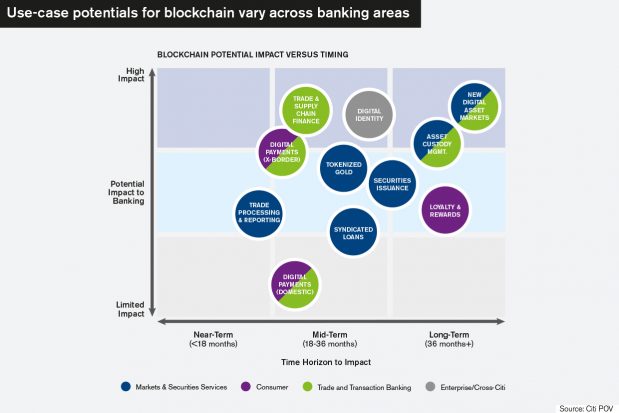Two members of the Citi Treasury and Trade Solutions team, Kris Van Broekhoven, Global Head of Commodity Trade Finance, and David Cooperman, Global Head of Trade Strategic Initiatives, discuss how innovation is promising to transform the way global trade business gets done.
Conducting trade has long been a highly manual, paper-dependent process. From bills of lading, to shipping and receiving documents, the legacy practices of trade have been around for hundreds of years. As digital transformation has taken hold across the global marketplace, out-of-date analog approaches are steadily being replaced with innovative new digitalised trade flows. Today, the industry is seeing a path toward end-to-end digitisation, as new technologies involving optical character recognition (OCR) and blockchain help to move us closer to the ultimate goal of straight-through processing (STP).
Citi is one of the leading banks at the centre of this evolving ecosystem, working to bring about STP in trade in order to help facilitate scale and efficiency, and improve risk mitigation. While there is much discussion about new players in the marketplace, banks remain the key players in moving trade into the digital age. In fact, due to the rapid pace of innovation and the complexity of the global marketplace, banks are increasingly collaborating to best support overall industry advances.
OCR remains key for manual and digital document processes
While the goal is complete digitisation, achieving this Holy Grail will likely take time, assuming it can ever be fully accomplished. In the meantime, there are certain parts of the industry that continue to cling to manual processes. For instance, in many parts of the world, goods traded require original documents to be received and retained for record-keeping purposes. In such cases, OCR can be used as a key to help bridge the gap between paper and digital documentation by converting files into a ‘machine readable’ format as early in the process as possible.
OCR provides the flexibility needed to allow preferred methods of processing trade documents, whether manual or digital, while still optimising efficiency. Citi is a leader in using OCR technology for trade. We use specialised OCR software to digitise paper-based documentation and automate key processing steps, which helps to deliver significant productivity savings, in many instances, by decreasing overall processing times, as well as improved risk controls and client experience.
Consortium forms to digitise commodity trade finance
In addition to OCR, banks are also looking to utilise technology to further streamline trade by creating digital ecosystems. One new example is focused on optimising the commodity trade finance industry where a consortium of banks has formed a digital and blockchain-based open financing platform, called komgo. Along with Citi, leading commodity finance banks and commodity traders are working to leverage blockchain technology to provide new financial offerings such as digital letters of credit (LCs) within the commodity trading ecosystem.
This consortium is also relying on input from a number of global commodity traders, who are influencing the design process and are part owners of the concept. With an ‘open-bank’ platform, the strategy can be adopted by multiple players, which in turn can help shape the effectiveness of the design. The goal has been to put a communication layer in place that allows buyers and sellers to interface with banks through a single platform, instead of having to deal with numerous bank portals. Working with a leading blockchain advisor to implement the strategy, the result is a comprehensive commodity trade finance platform that can potentially serve as the ‘go-to’ standard or common utility for the marketplace.
By developing this digital platform, the user experience is greatly improved since this strategy increases the ease of securing financing digitally while helping commodity traders increase the efficiency of their internal processes. Komgo has been testing its proof of concept with several pilot cases that focused on the processing of LC-based transactions.
The transactions involved multiple parties working together to create digital documents in support of the LC-backed trades. The success of these pilot cases has proven that it is possible to process and handle a transaction completely from contract signing, to the acceptance of the documents, through to the confirmation of payments, end-to-end in a digital way, without the need for any paper.
The collaboration that is making this blockchain-based open financing platform possible is critically important for the industry at large similar to the way SWIFT has provided a vital infrastructure for international payments. Like the SWIFT model, banks will still create their own capabilities and compete on servicing, but the core infrastructure will be co-owned and created by a consortium.
The benefits of a blockchain-based open financing platform
A blockchain-based open financing platform, such as the one developed by the komgo consortium, can potentially offer considerable benefits for commodity traders. By digitising documents, banks and corporates are able to reduce the need to collect, scan and re-key data, creating greater efficiency. This also eliminates manual tracking and reconciliation of paper trails and bilateral email, as blockchain allows for simultaneous access to critical documents by all authorised parties – anytime or anywhere.
Once data is extracted in the portal, it can flow through other bank and corporate systems, enabling greater automation and STP. At the same time, transaction speed is expedited, helping to save time and money. Beyond being a one-stop platform for financing, private blockchain, or similar technology, provides greater confidentiality through inherent cybersecurity controls.
We are approaching an inflection point for trade
Today’s trade flows are clearly a ripe opportunity for digitisation. However, due to the diversity of trade itself, it is unlikely a single solution will be possible. That is why OCR may be integral to integrate emerging platforms. As full end-to-end digital processes are developed, it will be necessary for systems to communicate directly with other systems, which is why establishing a common, industry-accepted language will be essential. Even within the blockchain community, there are many different coding languages, creating silos which are unable to connect with each other. The development of standard protocols will be key.
There is no doubt that we are currently at an inflection point in the trade industry. With OCR bridging the gap between digital and paper processes and new technologies changing the way we do business, it is clear investing in improving the client experience is a top priority. With many new pilot programmes being launched, within two to three years, the market will likely test which digital concepts will be embraced across the industry. And yet, despite the overall shift towards digitisation, the world probably will still remain divided between old and new. Connecting these two worlds presents both a challenge and an opportunity. From Citi’s perspective, the future of trade is going to be very exciting and OCR along with blockchain innovation is poised to transform the way business gets done.








